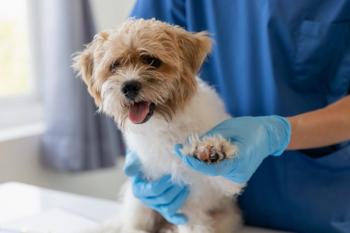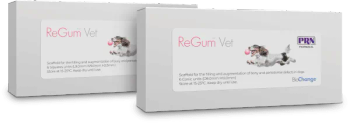
The ABCs of veterinary dentistry: A to C
The start of an alphabetic journey through the management of our veterinary patient's oral problems.
Our alphabet of 26 letters forms the foundation for billions of words. I've narrowed the list down to a mere 26 related to dental care in pets. I hope you enjoy this series of articles starting with A for dental anesthesia and ending with Z for dental zebras (I'm still searching for a good Y dental concept if you have one please email me at dentalvet@aol.com). Each letter holds major importance in our quest to do the best for our veterinary patients.
A is for Anesthesia
Most people recline in the dental chair, open their mouths and are OK with a suction tube placed under their tongues, probes placed into their sulci and radiograph sensors placed next to their teeth. But dogs and cats will not tolerate this without a fight-and who wants to fight? General anesthesia is needed to thoroughly clean, polish and examine the teeth and oral cavities in our patients (Figure 1).
Figure 1. A peek inside All Pets Dental, Dr. Bellow's veterinary practice in Weston, Florida. (Photos courtesy of Dr. Jan Bellows)
Unfortunately many of our clients are so worried about anesthetizing their dogs and cats that proper care is declined. How can you allay your clients' fears? Share with them the efforts you take to make anesthesia as safe as possible by choosing the right patient for anesthesia through preoperative testing, tailoring the anesthetic protocol, and monitoring the effects of anesthesia before and after the procedure.
Monitoring. Close patient monitoring is paramount during and after anesthesia. (All photos courtesy of Dr. Jan Bellows)
The American College of Veterinary Anesthesiologists (ACVA) recommends monitoring for:
- Circulation-Ensure that blood flow to tissues is adequate; measured via blood pressure.
- Oxygenation-Ensure adequate oxygen concentration in the patient's arterial blood; measured via pulse oximetry.
- Ventilation-Ensure that the patient's ventilation is adequately maintained; measured via capnography (Figure 2A).
- Temperature-Ensure avoidance of hypothermia, which is common in anesthetized dental patients and a source of trouble for perfusion and ventilation.
Figure 2A. An inline capnograph.
The ACVA recommends having a trained veterinary technician at the patient's side. The technician can respond to feedback from the electronic monitoring system, use his or her hands-on clinical expertise to manage the patient's proper anesthetic depth, and maintain an anesthetic record of significant events and trends in monitored parameters. In our procedures, the technician relays information to the veterinarian, who is apprised of the patient's condition at least every five minutes throughout the procedure (Figure 2B).
Figure 2B. A dental technician monitoring, relaying and recording anesthesia monitor findings.
How to monitor. Monitoring is accomplished through subjective methods (e.g. clinical appearance) and objective methods (e.g. electronic systems). During anesthesia, the patient should have minimal jaw tone and no palpebral reflex. The femoral pulse should be palpable, and the perfusion time should be two seconds or less. Breathing during balanced anesthesia should be even and regular.
Electronic monitors may detect anesthetic complications before being recognized by a trained clinician. In these situations, seconds count. Often, the advanced warning systems can head off problems before they become critical or do long-term damage. Electronic monitoring systems help to provide positive patient outcomes and reduce stress during the procedure.
Although many veterinary hospitals have accumulated a variety of monitoring devices, often single-parameter monitors, it would be wise to migrate to a 5-in-1 multiparameter monitor for all anesthetic procedures (Figure 2C). An ideal monitor includes noninvasive blood pressure measurement, capnography, pulse oximetry, electrocardiography and temperature. The advantages of a multiparameter monitor over individual devices include:
- More efficient for patient set-up and alarm management
- Consistent operating menu
- Ability to store, print and download data for all parameters
- Economy of scale-less expensive than acquiring individual devices
- Single point of contact for service, maintenance and troubleshooting
Figure 2C. A cat monitored during anesthesia with 5-in-1 parameter electric and apnea monitors.
Be aware that choosing a monitor that has been designed specifically for use on animals can make a significant difference in performance and accuracy.
Local anesthesia. Every oral procedure performed that may be painful should be accompanied by local anesthesia. The two most commonly performed local anesthetic blocks are the maxillary (Figure 2D) and mandibular (Figure 2E), which can be performed either intraorally or extraorally.
Figure 2D. Site for a maxillary nerve block. (Illustrations by Sathyanarayana)
Figure 2E. Site for a mandibular nerve block.
Honorable mentions for A-analgesia, apical, attached gingiva.
B and C are for the Basic Concepts of operative dentistry
Creating a dental treatment plan can be confusing and frustrating. As with other veterinary disciplines, dental diagnosis and care entails approximately one-third understanding of anatomy, physiology and dental principles; one-third recognition of disease; and one-third access to proper equipment and expertise to perform needed care.
Most dental problems can be treated by one of the eight options below:
1. Do nothing with the observed pathology other than future follow up. No immediate treatment is needed where there is a functional abnormality (i.e. even though the dentition is not normal, the animal is not experiencing adverse effects). One example of a functional abnormality is an enamel fracture that does not penetrate the dentin sufficiently to affect the pulp and where radiographs do not show pathology. Other cases where no treatment is the best course include functional malocclusion (Figure 3) and when the root of a tooth shows external resorption that does not extend into the oral cavity (Figure 4).
Figure 3. This left mandibular canine is malpositioned caudal to the maxillary canine but is not expected to cause a problem.
Figure 4. External resorption lesion (arrow) affecting the mesial root left mandibular fourth premolar. No intervention is necessary at this time.
2. Teeth cleaning, irrigation, polishing and application of professional plaque barriergel or dental sealant. These measures are indicated in cases of stage 1 gingivitis (inflamed gingiva without evidence of support loss) and stage 2 nonpocket periodontal disease (less than 25 percent support loss) as evidenced by gingival recession.
3. Periodontal treatment
Figure 5A. Bleeding is evident on probing.• Local antimicrobial administration of clindamycin hydrochloride (Clindoral-TriLogic Pharma) or doxycycline hyclate (Doxirobe-Zoetis) can be used to treat stage 1 bleeding on probing points (Figures 5A and 5B) and stage 2 (less than 25 percent of support loss) and stage 3 (25 to 50 percent support loss) periodontal disease when cleaned periodontal pockets (in contrast to gingival recession) are present and the pet owners can provide home care to control periodontal disease progression.
Figure 5B. Application of clindamycin hydrochloride.
• Surgery can save teeth if the tooth and patient are appropriate. Operculectomy (removal of the gingiva over a partially erupted tooth crown) is indicated in a young dog or cat (less than 8 months old) whose tooth is expected to fully erupt once the obstructing gingiva is excised (Figures 6A-6C). Open flap exposure for cleaning and débridement is used to expose a tooth root in selective cases where the periodontal pocket extends greater than 5 mm and the client is committed to save the pet's teeth despite a guarded prognosis.
Figure 6A. A missing mandibular first premolar evident on oral examination.
Figure 6B. The premolar is present on an intraoral radiograph.
Figure 6C. After an operculectomy, the premolar erupts normally.
4. Endodontic care
• Vital pulp therapy can be performed when a complicated tooth fracture is acute (no longer than two days). The treatment usually results in a vital tooth with a good prognosis. If the fractured tooth with pulp exposure has been present for more than two days, extraction or conventional root canal therapy should be performed with a more predictable outcome (Figures 7A-7C).
Figure 7A. A complicated left maxillary canine fracture in a cat.
Figure 7B. Application of mineral trioxide aggregate (MTA) on vital pulp.
Figure 7C. The restored vital canine.
• Root canal therapy is the treatment of choice for end-stage pulp disease secondary to fracture, chronic pulpitis or caries. Ideal therapy depends on the animal's age, the age of pulp exposure, the tooth's condition and periapical health (Figures 8A and 8B).
Figure 8A. A complicated crown fracture more than two days old.
Figure 8B. Root canal therapy was performed to save the tooth.
5. Crown reduction with gingival closure. This intervention can be used to treat Type 2 tooth resorption with evidence of root replacement (Figures 9A-9D). Crown reduction and restoration are indicated for cases of maloccluded teeth interfering with the opposing gingiva.
Figure 9A. Tooth resorption in a cat's mandibular third premolar.
Figure 9B. A radiograph of the same tooth consistent with type 2 root replacement resorption.
Figure 9C. Gingival exposure and crown amputation.
Figure 9D. After gingival closure.
6. Orthodontic intervention. Orthodontic buttons and elastics can be used to reposition teeth into functional occlusion and for maxillary or mandibular fracture stabilization. Inclined planes made from acrylic or metal can move mesioverted mandibular canines into functional positions (Figures 10A-10C).
Figure 10A. A mesioverted maxillary canine in a Shetland sheepdog.
Figure 10B. Orthodontic buttons and elastics were used to pull the canine caudally.
Figure 10C. A functional occlusion five months later.
7. Oral surgery. Surgery is the treatment of choice to care for many oral masses, both benign and malignant. When planning oral surgery, the goal is to achieve a 1-cm tumor-free margin for benign masses and a 2-cm or greater margin for malignant oral tumors.
8. Extraction
• Tooth extraction is indicated when stage 4 periodontal disease is present (the tooth has more than 50 percent support loss based on probing depths, greater than stage 2 mobility or gingival recession that has progressed past the mucogingival line).
• Extraction is the best therapy when the tooth has between 25 and 50 percent support loss and the owner or the patient will not allow appropriate allow home care.
• Some fractured teeth are best extracted, especially those that have pulp exposure and stage 3 or 4 periodontal disease or marked internal resorption.
• Extraction is indicated when root canal therapy is not a viable option due to the owner's wishes or the practice's capability (and lack of a referral option).
• Feline teeth should be extracted via flap exposure when, in addition to the resorption, there is visible periodontal ligament and normal opacity on intraoral radiographs (Types 1 and 3).
• Many cats affected by oropharyngeal inflammation that do not respond to home plaque control care benefit from the extraction of the teeth distal to the canines; those that still do not respond should have all the teeth extracted.
• Extra (supernumerary) teeth that cause crowding, predisposing the normal teeth to periodontal disease, should be extracted.
• Persistent primary (deciduous) teeth should be removed at the time of diagnosis to prevent the potentially harmful location of the adult teeth.
• Extraction is the treatment of choice for advanced caries.
Honorable mentions for B & C-bacteria, bupivacaine hydrochloride, bur, calculus, caries.
Next up …
What do you think Dr. Bellows has planned for D, E and F? Stay tuned to find out.
Newsletter
From exam room tips to practice management insights, get trusted veterinary news delivered straight to your inbox—subscribe to dvm360.






